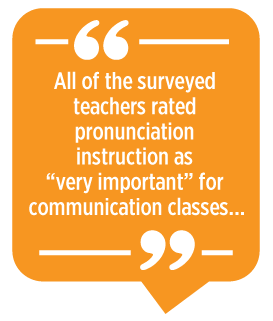Making Time for Pronunciation Instruction: 6 Strategies
by John Rothgerber
 Pronunciation instruction can provide important benefits to
students in regards to both comprehensibility and speech perception. As a
teacher, however, it can often feel overwhelming to fit pronunciation
instruction into an already busy lesson plan. In a 2012 survey of teachers
working in an intensive English program, 71% reported that they did not teach
pronunciation at all in their classes (Darcy et al., 2012). However, all of the
surveyed teachers rated pronunciation instruction as “very important” for
communication classes, and 92% rated it as either “very important” or
“important” for daily life. What accounted for the low rate of teaching despite
the perceived importance? According to the survey, the two main reasons were a
lack of time (43%) and a lack of training (25%).
Pronunciation instruction can provide important benefits to
students in regards to both comprehensibility and speech perception. As a
teacher, however, it can often feel overwhelming to fit pronunciation
instruction into an already busy lesson plan. In a 2012 survey of teachers
working in an intensive English program, 71% reported that they did not teach
pronunciation at all in their classes (Darcy et al., 2012). However, all of the
surveyed teachers rated pronunciation instruction as “very important” for
communication classes, and 92% rated it as either “very important” or
“important” for daily life. What accounted for the low rate of teaching despite
the perceived importance? According to the survey, the two main reasons were a
lack of time (43%) and a lack of training (25%).
The
availability of excellent reference books such as Teaching
Pronunciation: A Course Book and Reference Guide by
Celce-Murcia et al. (2010) can help teachers overcome a lack of familiarity
with the different features of English pronunciation, but insufficient class
time can remain a serious hurdle. For example, the communicative framework for
teaching pronunciation proposed by Celce-Murcia et al. (2010) includes the
following five stages for teaching a single feature:
-
description and
analysis
-
listening
discrimination
-
controlled
practice
-
guided practice
-
communicative practice
This is well-suited for a
course focused entirely on pronunciation, but it can be difficult to implement
in a more general communication or multiskills course, both in terms of
in-class time and preparation time.
 In the
following sections, I introduce several ideas and methods that I have found
useful for teaching pronunciation in a general communication or multiskills class
when time is a limiting factor.
In the
following sections, I introduce several ideas and methods that I have found
useful for teaching pronunciation in a general communication or multiskills class
when time is a limiting factor.
1. Incorporate Pronunciation Into Communicative Activities
Rather than
doing controlled activities targeted only at pronunciation, incorporate
pronunciation instruction into other communicative activities when time is
limited. For example, introduce question intonation before students do an
interview activity, or teach word stress before an activity that involves many
multisyllabic words. The intention is to draw awareness to a particular feature
of pronunciation and have students devote a portion of their attentional
resources to it while also accomplishing the communicative goals of the
activity. Students have a tendency to focus more on communication, but careful
monitoring and feedback can help keep the pronunciation goal in sight without
disrupting the communicative nature of the activity.
I find that
giving students the opportunity to practice pronunciation in this way has a
more positive impact on spontaneous speech than only using highly controlled
pronunciation activities or drills. Of course, when time is not a factor, more
controlled activities can also be useful, as in the communicative framework
(Celce-Murcia et al., 2010).
2. Prioritize
Suprasegmentals
Instruction in suprasegmentals (aspects of prosody
such as stress and intonation) seems to have a greater effect on improving
comprehensibility than instruction in segmentals (consonants and vowels; Gordon
et al., 2013). In my own experience, students are often highly aware and
sensitive to difficulties they have with pronunciation of individual speech
segments, but they remain relatively unaware of suprasegmental features.
Therefore, calling their attention to these features can have a greater impact
when time is limited.
I typically
introduce suprasegmentals in the following order:
-
word stress (with vowel
reduction, given their connected nature),
-
sentence stress (including
a focus on connected speech, reduced speech, and contractions), and
-
intonation and prominence.
This
order represents an easy-to-follow increase in scope, from word to complex
sentence. If time permits, I introduce consonants and vowels after
suprasegmentals.
3. Set a Narrow
Focus
I try to
always keep pronunciation instruction limited to small, easily digested
portions for any given lesson. Not only are students learning about new sounds,
they are also learning to shape their vocal tracts to make those sounds, all
while recalling vocabulary and constructing sentences to express ideas in their
second language. Keeping individual pronunciation lessons limited in scope can
increase the chances that students are able to maintain focus on pronunciation
as they also juggle the other factors involved in speech production. Doing so
also keeps pronunciation instruction more manageable when time is an
issue.

4. Give Brief Explicit
Instruction
Explicit
instruction is an important part of teaching pronunciation, because students
often have difficulty perceiving a feature or contrast that is absent from
their native language (Darcy, 2018). Rather than go into a detailed phonetic
analysis, however, try to keep this as brief as possible when time is limited.
The goal of explicit instruction should be to raise awareness of the target
feature and to describe, in simple terms, how it is produced. Diagrams and
visual aids, as well as varied examples, are helpful in doing this. Minimal
pairs can be used to demonstrate a contrast, such as the word stress contrast
seen between the noun PERmit and the verbperMIT. In addition, word-nonword pairs can also be used
when good minimal pairs are difficult to find (e.g.,MONkey and monKEY).
5. Focus on Frequent
Repetition
Improvements
made in isolated pronunciation drills often do not carry over to spontaneous
speech (Celce-Murcia et al., 2010). However, frequent repetition of the same
forms in communicative practice is an important step in developing
automatization, or the ability to automatically produce features of
pronunciation without focused effort (Gatbonton & Segalowitz, 2005).
Because of that, I always try to use communicative activities that involve high
repetition of the target feature.
For example,
if focusing on question intonation, then an activity that requires students to
constantly ask questions is ideal. For word stress or segmentals, carefully
select activity-critical vocabulary that contains the target feature. The
activity should be one that requires this vocabulary to be used frequently.
Before beginning, review the pronunciation of each word, and during the
activity, provide feedback specifically on those words. In future lessons, you
can draw on this same vocabulary for review activities. Especially when time is
limited, building automatization for a small selection of words or structures
will promote more generalization for the target features as students
advance.
6. Promote Independent
Growth
Improving
pronunciation is often a lengthy process that extends beyond a single course.
Students may have spent their entire language learning careers up to that point
encoding the wrong pronunciation in their mental lexicons if, for example, they
could not perceive the difference between /l/ and /ɹ/. As such, it is important
to encourage students to continue to focus on pronunciation outside of class.
To that end, we must give them the tools and knowledge to become independent
learners of pronunciation.
Introduce
the International Phonetic Alphabet (IPA) to your students and demonstrate how
it can be used to identify a word’s segments and location of word stress when
looking in a dictionary. You can have your students frequently record and
analyze their speech for homework, as well. For example, you might provide them
with a sample from an online video and ask them to record themselves imitating
the rhythm and stress of the speaker. Share with them the free website English Accent
Coach to practice listening to difficult consonant and vowel
contrasts. Such homework encourages students to practice pronunciation outside
of the classroom.
Conclusion
These ideas
have guided the way that I fit pronunciation instruction into an already busy
classroom, and I hope that they can serve as starting points for teachers who
may be looking to focus more on pronunciation in their classes. Providing
students with good pronunciation instruction can not only improve their
comprehensibility and perception, but it can also improve their confidence to
speak. Even with limited time, the benefits make it worthwhile and rewarding.
References
Celce-Murcia, M., Brinton, D. M.,
& Goodwin, J. M. (with Griner, B.). (2010). Teaching
pronunciation: A course book and reference guide (2nd ed.).
Cambridge University Press.
Darcy, I.
(2018). Powerful and effective pronunciation instruction: How can we achieve
it? CATESOL Journal, 30(1),
13–45.
Darcy, I.,
Ewert, D., & Lidster, R. (2012). Bringing pronunciation instruction
back into the classroom: An ESL teachers’ pronunciation “toolbox.” In J. Levis
& K. LeVelle (Eds.), Proceedings of the 3rd Pronunciation in
Second Language Learning and Teaching Conference (pp. 93–108). Ames,
IA: Iowa State University.
Gatbonton, E., & Segalowitz, N. (2005).
Rethinking communicative language teaching: A focus on access to fluency.Canadian Modern Language Review 61, 325–353.
Gordon, J., Darcy, I., &
Ewert, D. (2013). Pronunciation teaching and learning: Effects of explicit
phonetic instruction in the L2 classroom. In J. Levis & K. LeVelle
(Eds.). Proceedings of the 4th Pronunciation in Second Language
Learning and Teaching Conference (pp. 194–206). Ames, IA: Iowa State
University.
John Rothgerber is a PhD candidate in second language studies at Indiana University. His primary research focuses on the perception and lexical encoding of second language speech sounds. He has been teaching English in the United States and Japan for 15 years with a focus on oral communication and pronunciation.